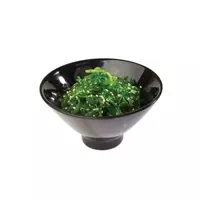Chuka seaweed

Seaweed began to be eaten by the ancient inhabitants of East Asia. The national cuisine of countries such as Japan, Thailand, Vietnam, Indonesia, Korea, the Philippines, China and Taiwan has dishes using various types of seaweed. Much later, seaweed began to be consumed by residents of the European part of the earth, as well as in Canada and Latin America.
There are many uses for seaweed in cooking. They are added to soups, to second courses, and also make healthy noodles from pansit algae. Such noodles are enriched with calcium, iodine and magnesium. In Asia, dried seaweed is popular (Japanese nori, Chinese porphyra and gim algae in Korea). They are added to the first courses, made chips from algae, as well as sushi and sashimi.
There are a huge variety of seaweed that is used not only in cooking, but also in medicine or the chemical industry. Algae are used in the production of medicines and dressings. Red seaweed of the chondrus crispi species is used in the production of food additives. In England, algae is added to bread, and in Belize, a drink is made from milk, cinnamon, nutmeg and vanilla.
Composition of chuka algae
Chuka seaweed (Hiyashi Wakame or Chuka) is considered a fairly popular ingredient in many dishes of traditional Japanese cuisine. The Japanese are famous for their careful approach to food selection. Residents of the land of the rising sun are distinguished by their rationality and discipline. For a long time, only healthy and necessary foods have been present in the daily diet of the Japanese, among which you can find chuka seaweed.
If you look at the composition of chuka algae, then the benefits of the product will become obvious. Vitamins C and E, as well as large amounts of iodine and calcium. The main benefit of the product for the human body lies in the unique vitamin-mineral composition of chuka algae of natural origin. Chuka algae are part of some traditional Japanese medicine products.
Doctors recommend eating chuka algae for people who suffer from diseases of the gastrointestinal tract. The calorie content of chuka algae is at a fairly low level. Nutritionists believe that seaweed should necessarily be included in the daily diet of people who follow the principles of a healthy and balanced diet. The healthy composition and low calorie content of chuka algae make it possible to classify this product as a dietary diet.
In Japan, chuka algae is used to make a vitamin salad of the same name. Masters of Japanese culinary art claim that seaweed is much more delicate than lettuce leaves. For example, Kaiso salad recipe, for which you need chuka seaweed, seeds and sesame oil, lemon juice, pepper and starch. The ingredients need to be mixed together, as a result, you get a Japanese Chuka or Kaiso salad, which can be used as an independent dish or as a filling in rolls.
seaweed chuka 90 kKal
Energy value of chuka seaweed (Ratio of proteins, fats, carbohydrates - ju):
Proteins: 1 g (~ 4 kCal)
Fats: 4g (~ 36kCal)
Carbohydrates: 12g (~ 48kCal)
Energy ratio (bj | y): 4% | 40% | 53%
 Español
Español Français
Français Português
Português Русский
Русский 简体中文
简体中文 繁體中文
繁體中文 日本語
日本語 한국어
한국어 العربية
العربية Türkçe
Türkçe Қазақ
Қазақ Deutsch
Deutsch Italiano
Italiano Українська
Українська
